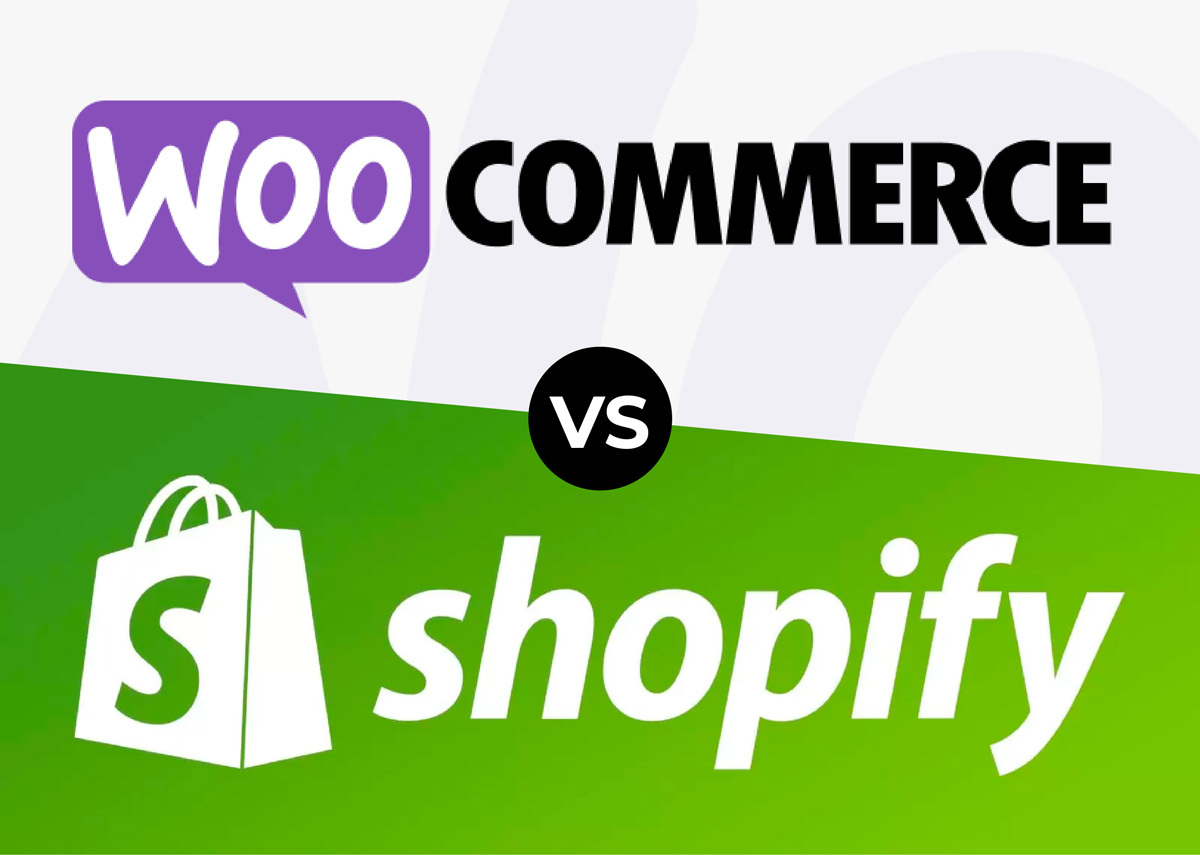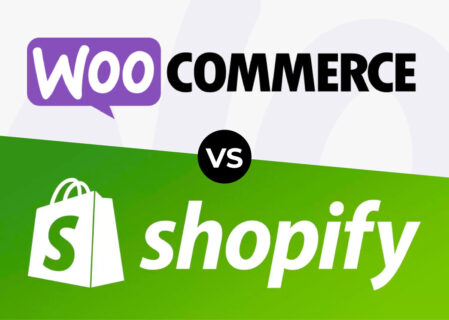Are you struggling to decide between Shopify and WooCommerce?
If you are thinking about launching an eCommerce store or adding an eCommerce element to your existing website, then you are probably debating whether to go for Shopify or WooCommerce – the world’s two most popular eCommerce platforms.
Both platforms have their good points, which can make it a really hard decision – especially for something so critical as an eCommerce store. To help you choose the right solution for your store, we will dig into each platform in this post and contrast the two.
Approach to eCommerce
Shopify and WooCommerce take two different approaches to creating and managing a store:
- Shopify is a hosted store, so Shopify host and manage the software for us, meaning we are limited to making the changes that Shopify allows us to make
- WooCommerce on the other hand is self-hosted, meaning files are located on your server and everything on your store can be modified as wanted
So, WooCommerce is more flexible than Shopify but is not as user friendly as Shopify, therefore if you (the client) want to manage the store yourself, then you may be better with Shopify. However, the fact that Shopify is beginner-friendly means there are some hard limits that you won’t encounter when using WooCommerce.
Market share
We are not advocating that you select an eCommerce solution based solely on popularity, but it is interesting to look at market share and what your competition might be using.
According to Statista, as of April 2021 Squarespace Online Stores was the worldwide leading eCommerce software platform with a market share of 23.51%, followed by WooCommerce with a share of 23.43%. Shopify trails behind with a market share of just 3.69%.
›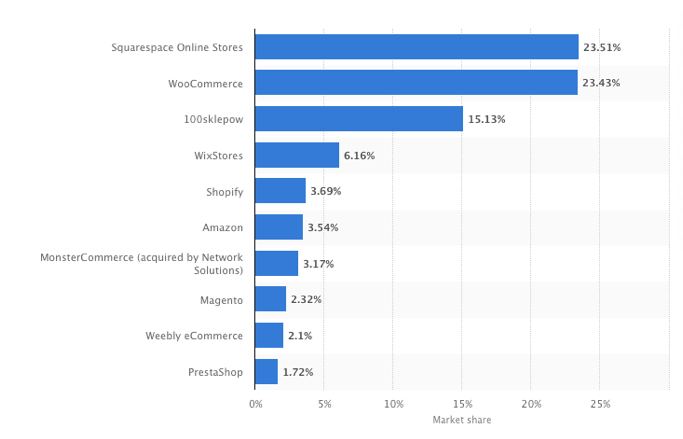
However, Builtwith shows that of the top 10K websites, only 8% use WooCommerce while 19% use Shopify, so it seems like Shopify is more heavily used on higher authority sites. It also highlights that there is still a lot of room for both of these platforms to grow in the enterprise space.›
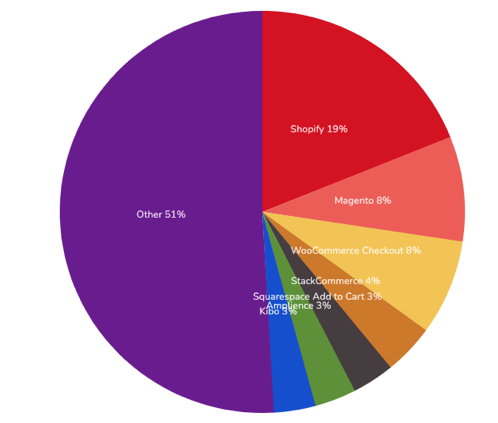
If we look at Google Trends for the last 5 years we can see that both have seen pretty steady growth in search terms, although Shopify has started to surpass WooCommerce on a worldwide basis.
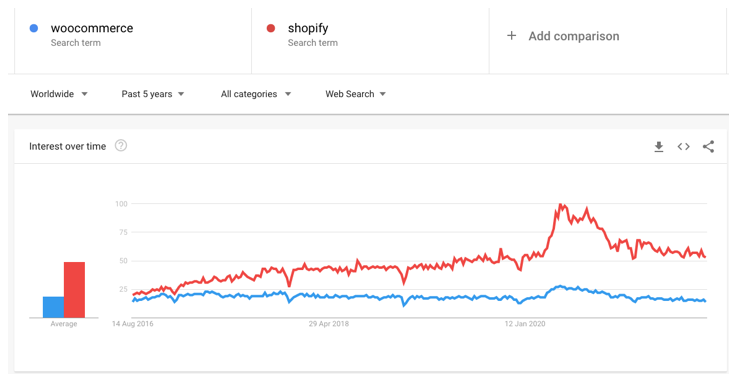
How easy is it to launch a store?
Shopify is the definite winner when it comes to going from nothing to launching a fully functioning store ready to process payments and accept orders.
Creating a WooCommerce store involves two things: having a WordPress site and installing and configuring WooCommerce on that. This involves:
- Finding hosting
- Installing WordPress
- Installing and configuring WooCommerce
- Finding a WooCommerce theme you like
- Configuring all the necessary things such as payment gateways, tax calculations and so on
Now, we are masters at this, of course, but it can be pretty daunting to those who are new to it.
Shopify, on the other hand, makes it much easier to create your first product and sell it. All we need to do is:
- Create a Shopify account
- Select and purchase a domain name, or sync it to an existing domain
- Choose your theme
If you choose to use Shopify’s own payment gateway then it is even simpler to start accepting card payments from day one.
How much control do we have over eCommerce store functionality?
Shopify is pretty flexible when it comes to hosted platforms, but it still doesn’t give us half as much control as we get with self-hosted WooCommerce sites.
With WooCommerce we can customise your store’s functionality through
- Theme choice
- 50,000+ WordPress plug-ins
- Custom code
WooCommerce also wins hands down in terms of product variations. With WooCommerce there are no hard limits on the number of product variations you can use, while Shopify has a cap of 100 variations per product no matter which plan you are on.
With Shopify, there is some scope for customisation in terms of themes and apps, but you can only add custom HTML to your home page. The tools available do offer a good deal of flexibility for a hosted platform, but there are some things you just can’t work around – and this doesn’t tend to happen with WooCommerce.
What payment methods does each eCommerce platform offer?
Both Shopify and WooCommerce offer a variety of payment options and you probably won’t notice a difference unless you are in a very niche market.
Shopify does charge extra fees for using external payment gateways, which can be as high as 2%, so you need to keep that in mind.
WooCommerce supports all the popular payment gateways, such as PayPal and Stripe, and they also offer access to lots of niche payment gateways such as Postgiro and Przelewy24.
Who controls the data on each eCommerce platform?
As WooCommerce is self-hosted it gives you significantly more control and ownership of your data. You own everything, so you can dig into the database and access the raw data whenever you want.
Shopify does give you access to your data, but it all sits on their servers so you never really fully control it. However, Shopify does offer lots of ways to access your data, which is better than most hosted platforms.
How is ongoing maintenance handled?
As Shopify is a hosted solution, its maintenance is much more carefree than WooCommerce’s.
Shopify handles maintenance and security of your store, so there is very little maintenance required in that sense, however, we still need to stay on top of apps used on your store so they continue to function properly.
As WooCommerce gives us ultimate control and ownership of the store, we are responsible for maintaining and securing it.
How much does each eCommerce platform cost?
This is hard to decide, as each platform has variable costs.
Shopify has core pricing that is transparent and easy for you to plan for.

However, things such as premium themes and apps may increase the cost of your store. Shopify will also charge you more if you use an external payment gateway.
It is more difficult to pin down an exact cost for WooCommerce as there are far too many options to take into account. The only fixed costs they have are:
- Hosting
- Domain
- Payment gateway
But you will probably also end up paying for a premium theme and plug-ins as well.
WooCommerce vs Shopify: Which one should you choose?
There is no right or wrong answer here. It is not clear cut. Each eCommerce platform has its advantages and disadvantages for specific situations.
The big reason to use WooCommerce over Shopify is the control and flexibility it offers. However, if you want the simplest way to launch an eCommerce site and don’t plan on selling any complicated products then Shopify is best.
Here at Zool, we are happy working with both. There are pros and cons to both so we tend to assess on a per-project basis. Contact us today to discuss which solution might be better for you
WooCommerce vs Shopify: Which is better?
eCommerce Digital Web Design and Development / Oct 4, 2021
Are you struggling to decide between Shopify and WooCommerce?
If you are thinking about launching an eCommerce store or adding an eCommerce element to your existing website, then you are probably debating whether to go for Shopify or WooCommerce – the world’s two most popular eCommerce platforms.
Both platforms have their good points, which can make it a really hard decision – especially for something so critical as an eCommerce store. To help you choose the right solution for your store, we will dig into each platform in this post and contrast the two.
Approach to eCommerce
Shopify and WooCommerce take two different approaches to creating and managing a store:
- Shopify is a hosted store, so Shopify host and manage the software for us, meaning we are limited to making the changes that Shopify allows us to make
- WooCommerce on the other hand is self-hosted, meaning files are located on your server and everything on your store can be modified as wanted
So, WooCommerce is more flexible than Shopify but is not as user friendly as Shopify, therefore if you (the client) want to manage the store yourself, then you may be better with Shopify. However, the fact that Shopify is beginner-friendly means there are some hard limits that you won’t encounter when using WooCommerce.
Market share
We are not advocating that you select an eCommerce solution based solely on popularity, but it is interesting to look at market share and what your competition might be using.
According to Statista, as of April 2021 Squarespace Online Stores was the worldwide leading eCommerce software platform with a market share of 23.51%, followed by WooCommerce with a share of 23.43%. Shopify trails behind with a market share of just 3.69%.
›
However, Builtwith shows that of the top 10K websites, only 8% use WooCommerce while 19% use Shopify, so it seems like Shopify is more heavily used on higher authority sites. It also highlights that there is still a lot of room for both of these platforms to grow in the enterprise space.›

If we look at Google Trends for the last 5 years we can see that both have seen pretty steady growth in search terms, although Shopify has started to surpass WooCommerce on a worldwide basis.

How easy is it to launch a store?
Shopify is the definite winner when it comes to going from nothing to launching a fully functioning store ready to process payments and accept orders.
Creating a WooCommerce store involves two things: having a WordPress site and installing and configuring WooCommerce on that. This involves:
- Finding hosting
- Installing WordPress
- Installing and configuring WooCommerce
- Finding a WooCommerce theme you like
- Configuring all the necessary things such as payment gateways, tax calculations and so on
Now, we are masters at this, of course, but it can be pretty daunting to those who are new to it.
Shopify, on the other hand, makes it much easier to create your first product and sell it. All we need to do is:
- Create a Shopify account
- Select and purchase a domain name, or sync it to an existing domain
- Choose your theme
If you choose to use Shopify’s own payment gateway then it is even simpler to start accepting card payments from day one.
How much control do we have over eCommerce store functionality?
Shopify is pretty flexible when it comes to hosted platforms, but it still doesn’t give us half as much control as we get with self-hosted WooCommerce sites.
With WooCommerce we can customise your store’s functionality through
- Theme choice
- 50,000+ WordPress plug-ins
- Custom code
WooCommerce also wins hands down in terms of product variations. With WooCommerce there are no hard limits on the number of product variations you can use, while Shopify has a cap of 100 variations per product no matter which plan you are on.
With Shopify, there is some scope for customisation in terms of themes and apps, but you can only add custom HTML to your home page. The tools available do offer a good deal of flexibility for a hosted platform, but there are some things you just can’t work around – and this doesn’t tend to happen with WooCommerce.
What payment methods does each eCommerce platform offer?
Both Shopify and WooCommerce offer a variety of payment options and you probably won’t notice a difference unless you are in a very niche market.
Shopify does charge extra fees for using external payment gateways, which can be as high as 2%, so you need to keep that in mind.
WooCommerce supports all the popular payment gateways, such as PayPal and Stripe, and they also offer access to lots of niche payment gateways such as Postgiro and Przelewy24.
Who controls the data on each eCommerce platform?
As WooCommerce is self-hosted it gives you significantly more control and ownership of your data. You own everything, so you can dig into the database and access the raw data whenever you want.
Shopify does give you access to your data, but it all sits on their servers so you never really fully control it. However, Shopify does offer lots of ways to access your data, which is better than most hosted platforms.
How is ongoing maintenance handled?
As Shopify is a hosted solution, its maintenance is much more carefree than WooCommerce’s.
Shopify handles maintenance and security of your store, so there is very little maintenance required in that sense, however, we still need to stay on top of apps used on your store so they continue to function properly.
As WooCommerce gives us ultimate control and ownership of the store, we are responsible for maintaining and securing it.
How much does each eCommerce platform cost?
This is hard to decide, as each platform has variable costs.
Shopify has core pricing that is transparent and easy for you to plan for.

However, things such as premium themes and apps may increase the cost of your store. Shopify will also charge you more if you use an external payment gateway.
It is more difficult to pin down an exact cost for WooCommerce as there are far too many options to take into account. The only fixed costs they have are:
- Hosting
- Domain
- Payment gateway
But you will probably also end up paying for a premium theme and plug-ins as well.
WooCommerce vs Shopify: Which one should you choose?
There is no right or wrong answer here. It is not clear cut. Each eCommerce platform has its advantages and disadvantages for specific situations.
The big reason to use WooCommerce over Shopify is the control and flexibility it offers. However, if you want the simplest way to launch an eCommerce site and don’t plan on selling any complicated products then Shopify is best.
Here at Zool, we are happy working with both. There are pros and cons to both so we tend to assess on a per-project basis. Contact us today to discuss which solution might be better for you
Array